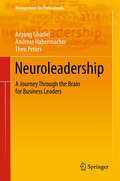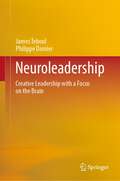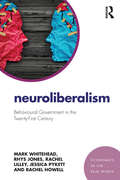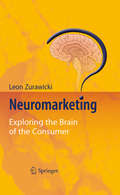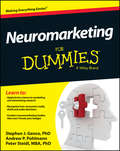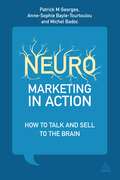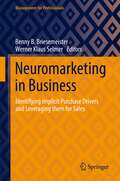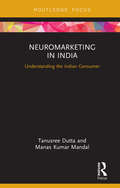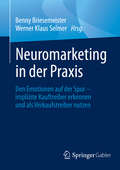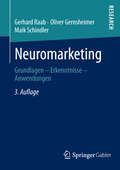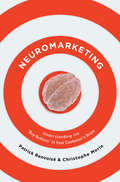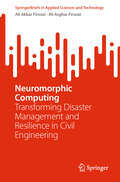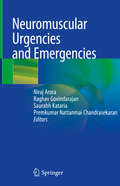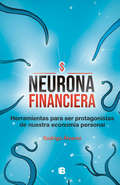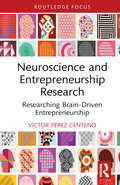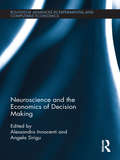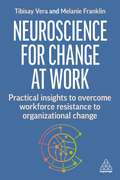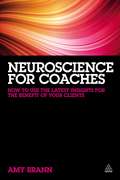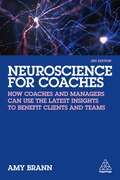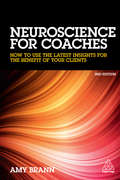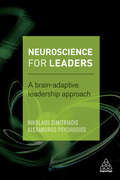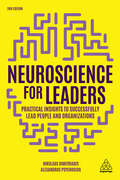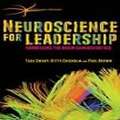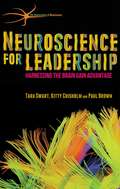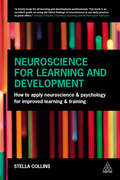- Table View
- List View
Neuroleadership: A Journey Through the Brain for Business Leaders
by Theo Peters Argang Ghadiri Andreas HabermacherThis book takes you on a journey through the brain, its function and its impact on leadership. The young business field of neuroleadership is founded on the belief that understanding the brain can give leaders new and powerful insights into human behaviour and how to effectively tap into that knowledge to generate better returns in business. The book approaches the background, history, and major thinkers in the field, but also reassesses the fundamental concept of neuroleadership. The authors look into the fundamental basic needs of human beings, how they are represented in the neural networks, and how this manifests in motivational drives. The book also focuses explicitly on how impactful organisational tools can be from the viewpoint of the brain. By following this methodology, the reader will be able to use the knowledge of neuroscience at the workplace to better address individuals' brains and hence tap into the full power of brains in business.
Neuroleadership: Creative Leadership with a Focus on the Brain
by James Teboul Philippe DamierThis book illustrates, through a number of examples from different domains, how to put in place a disciplined process to develop a creative leadership approach. Today's managers seem to have all the tools at their disposal, leadership training, seminars and executive coaching, to exercise effective leadership, but most continue to take the easy path of raw authority, neglecting the interwoven texture of leadership and followership. The classic models of leadership fail routinely because leaders find it hard to develop an effective way of motivating their followers and do not realize how far they are conditioned by the limitations and biases hardwired in their brains. Just like sports professionals who need a good understanding of their body, leaders need to practice and explore the capabilities of their brains. With some knowledge in the latest discoveries in Neurosciences and mastery of their cognitive predispositions, leaders can draw on a range of resources to engage all parties in learning and collaborating towards common goals and create a culture based on cooperation and innovation. Ideal for organizations or associations, private or public companies, this book offers practical advice on neuroleadership through examples of successful transformation including a case study at Netflix.
Neuroliberalism: Behavioural Government in the Twenty-First Century (Economics in the Real World)
by Rhys Jones Mark Whitehead Jessica Pykett Rachel Lilley Rachel HowellMany governments in the developed world can now best be described as ‘neuroliberal’: having a combination of neoliberal principles with policy initiatives derived from insights in the behavioural sciences. Neuroliberalism presents the results of the first critical global study of the impacts of the behavioural sciences on public policy and government actions, including behavioural economics, behavioural psychology and neuroeconomics. Drawing on interviews with leading behaviour change experts, organizations and policy-makers, and discussed in alignment with a series of international case studies, this volume provides a critical analysis of the ethical, economic, political and constitutional implications of behaviourally oriented government. It explores the impacts of the behavioural sciences on everyday life through a series of themes, including: understandings of the human subject; interpretations of freedom; the changing form and function of the state; the changing role of the corporation in society; and the design of everyday environments and technologies. The research presented in this volume reveals a diverse set of neuroliberal approaches to government that offer policy-makers and behaviour change professionals a real choice in relation to the systems of behavioural government they can implement. This book also argues that the behavioural sciences have the potential to support much more effective systems of government, but also generate new ethical concerns that policy-makers should be aware of.
Neuromarketing
by Leon ZurawickiOver the last 10 years advances in the new field of neuromarketing have yielded a host of findings which defy common stereotypes about consumer behavior. Reason and emotions do not necessarily appear as opposing forces. Rather, they complement one another. Hence, it reveals that consumers utilize mental accounting processes different from those assumed in marketers' logical inferences when it comes to time, problems with rating and choosing, and in post-purchase evaluation. People are often guided by illusions not only when they perceive the outside world but also when planning their actions - and consumer behavior is no exception. Strengthening the control over their own desires and the ability to navigate the maze of data are crucial skills consumers can gain to benefit themselves, marketers and the public. Understanding the mind of the consumer is the hardest task faced by business researchers. This book presents the first analytical perspective on the brain - and biometric studies which open a new frontier in market research.
Neuromarketing For Dummies
by Peter Steidl Andrew Pohlmann Stephen GencoLearn how to use neuromarketing and understand the science behind it Neuromarketing is a controversial new field where researchers study consumers' brain responses to advertising and media. Neuromarketing and the brain sciences behind it provide new ways to look at the age-old question: why do consumers buy? Neuromarketing For Dummies goes beyond the hype to explain the latest findings in this growing and often misunderstood field, and shows business owners and marketers how neuromarketing really works and how they can use it to their advantage. You'll get a firm grasp on neuromarketing theory and how it is impacting research in advertising, in-store and online shopping, product and package design, and much more. Topics include:How neuromarketing worksInsights from the latest neuromarketing researchHow to apply neuromarketing strategies to any level of advertising or marketing, on any budgetPractical techniques to help your customers develop bonds with your products and servicesThe ethics of neuromarketingNeuromarketing for Dummies demystifies the topic for business owners, students, and marketers and offers practical ways it can be incorporated into your existing marketing plans.
Neuromarketing in Action
by Patrick M Georges Michel Badoc Anne-Sophie Bayle-TourtoulouProviding a focused and in-depth examination of the field of marketing research that studies consumers' sensorimotor, cognitive and affective responses to marketing stimuli, Neuromarketing in Action is the first book to show both the scientific frameworks and the practical applications of this increasingly popular marketing tool.Through 18 chapters, referencing many global brands such as Aston Martin, Chanel, Lacoste, Amazon, Nike, Carrefour and Dunhill, the authors showcase the latest thinking on brain function and intelligence, and the subconscious influences on consumer behaviour. The book then examines the ways in which marketing efficiency can be improved through the satisfaction of the customer's senses, emotions, memory and conscience and looks at the impact on current marketing activities (selling methods, sensory marketing, product modification) and future strategies (value innovation, sensory brands, increased interaction with social networks and permission marketing).Neuromarketing in Action provides both a practical review of current thinking and a detailed review of future developments, showing how the latest marketing techniques can be validated and legitimized through the prism of the consumer brain.
Neuromarketing in Business: Identifying Implicit Purchase Drivers and Leveraging them for Sales (Management for Professionals)
by Werner Klaus Selmer Benny B. BriesemeisterThis book shows how neuromarketing works in practice. It describes how companies can use the methods and insights of neuroscience to make better decisions themselves. It brings together real-world use cases in the area of applied neuroscience, collected from the globally leading consumer neuroscience companies and their clients. The use cases come from a variety of business areas, from advertising research to store design, from finding the right name for a brand to designing a compelling website. The book reveals how clients engage in neuromarketing; the business problems they can encounter, and have encountered, solving with this new approach; and the values they generate.
Neuromarketing in India: Understanding the Indian Consumer (Routledge Focus on Management and Society)
by Tanusree Dutta Manas Kumar MandalHow to understand human behaviour has been a very intriguing question to medicine, computer science, economics, psychology and finance. Each discipline has been trying to study and predict human behaviour through surveys, laboratory-based experiments, questionnaires, interviews, statistics, focus groups; the list is endless. The lack of precision in the existing techniques to predict human behaviour has motivated researchers to move beyond the traditional and search for new and improved techniques. Neuroscience has stepped in to fill this gap. It is based on the assumption that human behaviour is a complex process which has a neural basis and the locus of this process is the higher centre of the brain. Both conscious and unconscious processing of stimulus in the brain is responsible for generating behaviour. So if we could develop a deeper understanding of how the brain functions to generate behaviour, we would be more confident in our understanding and prediction of consumer behaviour. The use of neuroscientific techniques, like functional Magnetic Resonance Imaging (fMRI), Electroencephalography (EEG), Evoked Response Potential (ERP), and sensors to measure changes in one's physiological state, to understand the mind of the consumer has just begun, and professionals in the field see a huge opportunity for neuromarketing in India. In the domain of neuromarketing, one important question relates to the distinction between Indian and other global consumers of commercial products. Are we different from consumers across the globe? The answer is probably ‘yes’. This is documented by the fact that we find a distinct change in the marketing strategy of companies; the methods to influence Indian consumers are different from those adopted in other countries. This gives rise to the question: what makes us different? The next logical question that arises, assuming that we are different or similar, is can we quantify it? Answering why, what and how we are different marks the beginning of the book, followed by issues related to the ethicality of using such techniques to promote marketing, risk analysis in case of failure and future directions in neuromarketing. The book intends to address each of these issues so that a comprehensive reading in the subject matter would help academicians to decipher consumer behaviour and build theory for possible principles of application in the market.
Neuromarketing in der Praxis: Den Emotionen auf der Spur – implizite Kauftreiber erkennen und als Verkaufstreiber nutzen
by Benny Briesemeister Werner Klaus SelmerDieses Buch zeigt, wie Neuromarketing in der Praxis funktioniert. Es beschreibt, wie Unternehmen die Methoden und Erkenntnisse der Neurowissenschaft nutzen können, um selbst bessere Entscheidungen zu treffen. Die führenden Neuromarketeers Deutschlands lassen den Leser an ihren Erfahrungen teilhaben und geben tiefe Einblicke in bewährte Vorgehensweisen – praxisnah anhand konkreter Fallstudien und Beispiele.Wenn Sie nutzerzentriert erfolgreich arbeiten wollen, müssen Sie das Verhalten von Menschen verstehen. Sie müssen verstehen, was Menschen bewegt, eine Dienstleistung oder ein Produkt zu nutzen, und welche Umstände sie davon abhalten könnten. Der Schlüssel zum Verständnis liegt in der emotionalen Nutzererfahrung des potenziellen Kunden.Das Buch beantwortet folgende Fragen:Wie kann man sich Neuromarketing ganz praktisch vorstellen? Wie läuft eine Studie ab und welche Ergebnisse kann ein beauftragendes Unternehmen erwarten?Wie lassen sich moderne neurowissenschaftliche Erkenntnisse in businessrelevante Handlungsempfehlungen übersetzen?Wie können Marketeers in Industrie und Handel mit Methoden des Neuromarketings die handlungstreibenden Emotionen ihrer Kunden schneller und tiefgreifender messbar machen und verstehen?
Neuromarketing: Grundlagen - Erkenntnisse - Anwendungen
by Gerhard Raab Oliver Gernsheimer Maik SchindlerAls interdisziplinärer Ansatz der Wirtschaftswissenschaften, der Psychologie und der Neurowissenschaften besteht der Anspruch des Forschungsgebiets Neuromarketing darin, neue Erkenntnisse für das Marketing zu generieren. Die Autoren geben in dieser überarbeiteten und aktualisierten Auflage einen fundierten Einblick in das noch junge Forschungsgebiet. Zum Verständnis und der Anwendung des Neuromarketing werden die notwendigen neurologischen und biologischen Grundlagen vermittelt und die Untersuchungsmethoden erläutert. Die Erkenntnisse und Implikationen für unterschiedliche Marketing-Bereiche, wie Markenführung und Kundenverhalten, werden anhand von praktischen Beispielen und Untersuchungsergebnissen beschrieben und analysiert.
Neuromarketing: Understanding the Buy Buttons in Your Customer's Brain
by Patrick Renvoise Christophe MorinHow can the latest brain research help increase your sales? Because people are inundated daily by an average of 10,000 sales messages, selling is now tougher than ever. That's why you need to learn what neuroscience has uncovered that will immediately increase your selling and influencing effectiveness.Unveiling the latest brain research and revolutionary marketing practices, authors Patrick Renvoisé and Christophe Morin teach highly effective techniques to help you deliver powerful, unique, and memorable presentations that will have a major, lasting impact on potential buyers such as:The 6 stimuli that always trigger a response / The 4 steps to align content and delivery of your message / The 6 message building blocks to address the "old brain" / The 7 powerful impact boosters to set your delivery apart from the rest. Once you know how the decision-making part of the brain works, you'll quickly begin to deliver more convincing sales presentations, close more deals, create more effective marketing strategies, and radically improve your ability to influence others.
Neuromorphic Computing: Transforming Disaster Management and Resilience in Civil Engineering (SpringerBriefs in Applied Sciences and Technology)
by Ali Akbar Firoozi Ali Asghar FirooziThis book delves into the transformative potential of neuromorphic computing within the field of civil engineering, specifically focusing on its application to disaster management. With the increasing frequency and severity of natural disasters, traditional disaster management systems face significant challenges in prediction accuracy, response time, and effective resource allocation. Neuromorphic computing, inspired by the neural processes of the human brain, offers a revolutionary approach to addressing these challenges. Through an in-depth exploration, this book outlines the theoretical foundations of neuromorphic computing, its integration into smart infrastructure, and the development of advanced predictive models for natural disasters such as earthquakes, floods, and urban fires. Additionally, it examines the technical, ethical, and social considerations inherent in deploying these technologies, alongside a vision for their future development. The convergence of neuromorphic computing and civil engineering heralds a new era of enhanced resilience, where more informed, rapid, and effective disaster management strategies are not just a possibility but a reality. The book contributes to the discourse on leveraging cutting-edge computing technologies to foster safer, more resilient communities in the face of natural calamities.
Neuromuscular Urgencies and Emergencies
by Raghav Govindarajan Niraj Arora Saurabh Kataria Premkumar Nattanmai ChandrasekaranThis book functions as a practical reference for recognizing various patient presentations, signs, and symptoms that must be considered when treating neuromuscular disorders (NMD). It emphasizes the importance of recognizing these preexisting conditions as this can be crucial to treating patients properly with appropriate medications and procedures.Concise yet comprehensive, this 10-chapter guide analyses various neuromuscular weaknesses including respiratory and progressive muscle weakness. Chapters address the involvement of multiple organ systems in NMD, with specific attention to cardiomyopathy, cardiac arrhythmias, and dystrophinopathies. Discussions also address the challenges practitioners face when treating vulnerable demographics such as pregnant women and those with hyper metabolic conditions. Written by experts in the field, Neuromuscular Urgencies and Emergencies is an invaluable resource for neurologists, emergency medicine physicians, physician assistants, and the interventional neurologist.
Neurona financiera: Herramientas para ser protagonistas de nuestra economía personal
by Rodrigo ÁlvarezA lo largo de 16 capítulos el autor nos acompañará a revisar nuestras decisiones financieras, organizar nuestra economía y ver con optimismo nuestro futuro económico. La construcción de un Plan Financiero Personal que nos ayude a vivir nuestra economía sin estrés. ¿Es posible cambiar mi situación financiera? ¿Cómo puedo manejar las deudas? ¿Cómo ahorrar en pos de un objetivo? ¿Puedo cambiar mis hábitos de consumo? Estas son solo algunas de las preguntas que en estas páginas encontrarán respuesta. Luego de años de estudio y trabajo, a partir de cientos de casuísticas, el autor ha desarrollado un sistema que ayuda a evitar el estrés por el dinero. No importa dónde estemos ubicados financieramente, estas páginas se convierten en una herramienta eficaz. En tiempos de incertidumbre Neurona financiera funciona como una brújula para llegar a tierra firme; en tiempos de tranquilidad es un barco que nos llevará a tierras más fértiles aún. Este libro se transforma en un mapa que nos llevará a tener una relación saludable con el dinero para alcanzar nuestros objetivos. Nos guiará por territorios difíciles, nos preguntará cómo era nuestro vínculo con el dinero en la infancia y sus consecuencias en el presente, nos enfrentará con los hábitos de consumo y nuestra situación con el endeudamiento. Pero también nos ayudará a definir nuestros objetivos financieros, señalando las claves para recorrer el camino hacia nuestros objetivos. Con herramientas al alcance de la mano, con un estilo sencillo y ameno, Rodrigo Álvarez nos acompañará a leer nuestro presente económico para proyectarnos hacia un futuro bajo nuestro control.
Neuroscience and Entrepreneurship Research: Researching Brain-Driven Entrepreneurship (Routledge Focus on Business and Management)
by Víctor Pérez CentenoThis book asserts the emergence of the fourth era of entrepreneurship, based on a brain-driven approach to the study, instruction, and practice of entrepreneurship. This paradigm shift stems from the need to incorporate appropriate neurotechnologies into the exploration and enhancement of entrepreneurial phenomena in order to best address the field's methodological challenges. The author explains why a paradigm shift is necessary in the field of entrepreneurship and provides the foundational guidelines for those interested in implementing it. Furthermore, a model of entrepreneurial enhancement is conceptualized and signalled as the ultimate goal of this new era. Scholars, practitioners, policymakers, and students interested in advancing entrepreneurship's contribution to academia, business, and society at large will benefit from this new era's multidisciplinary perspective and unique strengths.
Neuroscience and the Economics of Decision Making (Routledge Advances In Experimental And Computable Economics Ser. #5)
by Alessandro InnocentiIn the last two decades there has been a flourishing research carried out jointly by economists, psychologists and neuroscientists. This meltdown of competences has lead towards original approaches to investigate the mental and cognitive mechanisms involved in the way the economic agent collects, processes and uses information to make choices. This research field involves a new kind of scientist, trained in different disciplines, familiar in managing experimental data, and with the mathematical foundations of decision making. The ultimate goal of this research is to open the black-box to understandthe behavioural and neural processes through which humans set preferences and translate these behaviours into optimal choices. This volume intends to bring forward new results and fresh insights into this matter.
Neuroscience for Change at Work: Practical Insights to Overcome Workforce Resistance to Organizational Change
by Melanie Franklin Tibisay VeraHow do I communicate change to the business? How do I maintain productivity and wellbeing during change? How do I deal with resistance to business change?Neuroscience for Change at Work answers these questions and explains how to use insights from neuroscience when designing change and communicating it to employees. It is based on the PEPE model which outlines the four fundamental principles that drive resistance to change in individuals, teams and the wider organization. This book provides specific coverage of how neuroscience can inform change initiatives in remote, hybrid and in-person working environments to ensure successful business transformation in any working model. There is also discussion of how change can impact employee mental health and wellbeing and explains how using insights from neuroscience can help to safeguard this. There is also discussion of how to handle competing priorities from different groups of employees during times of business change. Every chapter of Neuroscience for Change at Work is supported by practical examples, tips, tools and case studies as well as robust, evidence-based insights from neuroscience. Co-authored by a neuroscientist with extensive experience in applying neuroscience to business transformation projects, this book is a practical guide for all change managers and anyone responsible for employee engagement, wellbeing and productivity during times of change.
Neuroscience for Coaches
by Amy BrannThe world of coaching is competitive. Organisations want coaches who deliver results, and can prove it. Many coaching tools and techniques are now fairly well established - but how do they actually work? The coach who can answer this question credibly and convincingly is sought after. This ground-breaking book equips coaches with cutting edge neuroscience information that will help them deliver greater value to their clients. It covers the foundations that coaches need to be aware of and crucially, the ways they can use this new information effectively and practically in their everyday work. Readers will strengthen their kitbag of coaching tools and will be able to explain to their clients the neurological underpinning of the techniques they are using. No forward-thinking coach can afford to be ignorant of recent scientific developments: Neuroscience for Coaches will give them the practical knowledge they need.
Neuroscience for Coaches: How coaches and managers can use the latest insights to benefit clients and teams
by Amy BrannMany coaching tools and techniques are now well established, but how do they actually work? The third edition of Neuroscience for Coaches answers this question to help coaches and managers deliver greater value to clients and employees.Based on extensive research, Neuroscience for Coaches provides a clear explanation of the aspects of neuroscience that are relevant to coaching so coaches can describe to clients why particular techniques work and the benefits to be gained from using them. It also features interviews with Marshall Goldsmith, Susan Grandfield, Christian van Nieuwerburgh and Kim Morgan on topics including mindfulness and behaviour change in coaching.This fully updated third edition covers the latest neuroscientific research on key brain areas and their functions, such as the Prefrontal cortex and Amygdala which affect attention, processing and emotional regulation. With tips and insights throughout, it crucially demonstrates the ways in which coaches and managers who coach can use this information effectively and practically in their everyday work. Neuroscience for Coaches is a vital resource for improving coaching practice with the latest scientific developments, tools and techniques.
Neuroscience for Coaches: How to Use the Latest Insights for the Benefit of Your Clients
by Amy BrannMany coaching tools and techniques are now fairly well established, but how do they actually work? Neuroscience for Coaches equips coaches with information that will help them answer this question and therefore deliver greater value to clients. Based on over twelve years of research, this book provides a clear explanation of the aspects of neuroscience that are relevant to coaching so you can describe to clients from a neuroscientific perspective why particular techniques and methods work and the benefits to them.This fully updated 2nd edition of Neuroscience for Coaches includes new interviews with Marshall Goldsmith, Susan Greenfield, Christian van Nieuwerburgh and Kim Morgan, along with new material on oxytocin, goals and mindfulness. It covers the latest neuroscientific research and, crucially, the ways in which coaches can use this information effectively and practically in their everyday work. Neuroscience for Coaches is a vital resource for keeping up to date with recent scientific developments, tools and techniques in coaching.
Neuroscience for Leaders: A Brain Adaptive Leadership Approach
by Dr Nikolaos Dimitriadis Dr Alexandros PsychogiosTo behave more productively in complex business situations, we need to understand and alter the inner workings of our brain. With insight from applied neuroscience, behavioural economics and psychology, the brain can be retrained and become our most valuable asset. Neuroscience for Leaders takes a practical approach and offers an easy-to-implement framework for making the behavioural changes to become a more effective leader. Drawing on research and practical experience, the authors present a flexible framework for fine-tuning the leadership brain. The Brain Adaptive Leadership approach is a step-by-step guide to enhancing the way you think, understanding and nurturing emotions, shaping automated brain responses, and developing dynamic relations. Neuroscience for Leaders explains both the underlying science and how to apply its findings in business, demonstrating why and how you can become a better leader through brain-based learning. With tools, managerial tips and clear actions to implement the method straight away, Neuroscience for Leaders is an invaluable companion to managers and leaders who want to gain the brain edge.
Neuroscience for Leaders: Practical Insights to Successfully Lead People and Organizations
by Dr Nikolaos Dimitriadis Dr Alexandros PsychogiosUnlock your potential with the latest neuroscientific insights and succeed as a leader in complex business environments.As understanding of neuroscience increases, it is better understood how scientific insights can be applied to develop and enhance leadership. Neuroscience for Leaders captures the most up-to-date and important findings in neuroscience and links these to the business world. This guide offers a simple framework to put these principles into practice to make better decisions, take the right actions and find faster solutions.Now in its second edition, this book presents a comprehensive approach to leading people and organizations based on academic research. The authors' 'Brain Adaptive Leadership' approach offers a step-by-step guide to enhancing the way leaders think, understanding and nurturing emotions, shaping automated brain responses and developing dynamic relationships. Examples, activities and practical suggestions are all designed to be clear and engaging. Neuroscience for Leaders is the essential guide for leaders who are ready to gain the business advantage scientifically.
Neuroscience for Leadership
by Paul Brown Tara Swart Kitty ChisholmLeadership can be learned: new evidence from neuroscience clearly points to ways that leaders can significantly improve how they engage with and motivate others, allowing them and their organizations to continue discovering their potential. This book provides leaders and managers with a guide to practical, effective actions, based on neuroscience, explained in an accessible way. It focuses on the competencies and capabilities that leaders and managers need, to think creatively, take good decisions, improve their performance and resilience, deal with complexity, incentivize, and innovate, rather than focusing on brain regions or even functional pathways within the brain. This book comes from three authors who combine knowledge and experience in applied neuroscience, psychiatry, organizational psychology, learning and leadership coaching at a world class level.
Neuroscience for Leadership: Harnessing the Brain Gain Advantage (The Neuroscience of Business)
by Paul Brown Kitty Chisholm T. SwartLeadership can be learned: new evidence from neuroscience clearly points to ways that leaders can significantly improve how they engage with and motivate others. This book provides leaders and managers with an accessible guide to practical, effective actions, based on neuroscience.
Neuroscience for Learning and Development
by Stella CollinsNeuroscience for Learning and Development is about the psychology and neuroscience that underpins effective and successful training and learning. It introduces the latest research and concepts and suggests practical tools, techniques and ideas to improve how trainers train and how people learn. Readers will find new and more effective ways of working and will discover a sound basis for good practice. They will also discover the research that backs up what they are already doing well and evidence to support future projects and plans in order to make a convincing case to budget holders. Neuroscience for Learning and Development covers the design and delivery of face-to-face, online and virtual learning as well as how to create environments which make learning easier. It provides evidence to stop training and learning being seen as 'soft and fluffy' and will help trainers and L&D teams persuade the rest of their organization of their value. This book explains the science behind creative training delivery so that learners will be motivated, enjoy training, pay attention, remember what they learn and be able to apply it back at work. It explains the neuroscience of attention, memory and habits and how to make sure people learn what they need to learn. Readers will be able to distinguish the neuromyths from the neuroscience and will find out which elements of brain science offer evidence for current practice and as well as discovering new ideas to continue to develop their skills and practice.
